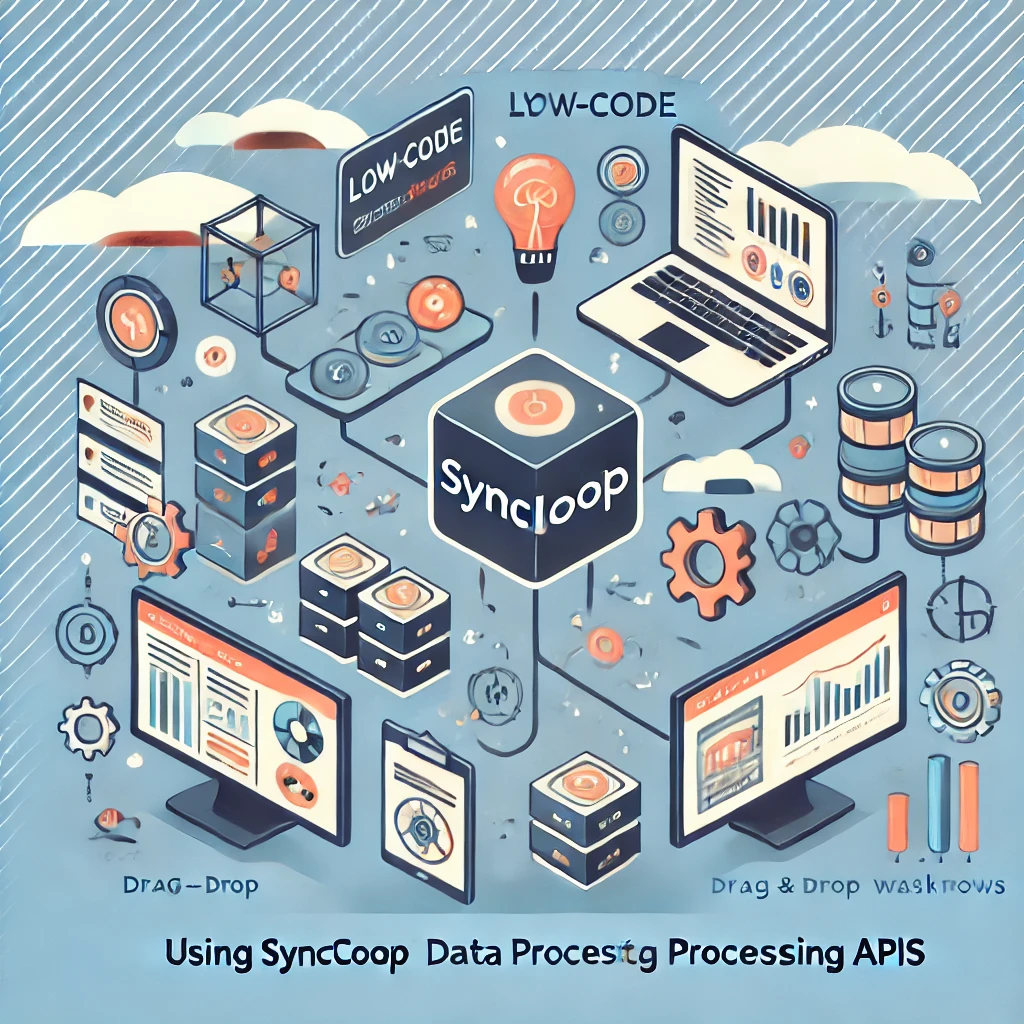Using Syncloop for Low-Code Data Processing APIs

Syncloop’s low-code platform simplifies the creation of data processing APIs, allowing developers to focus on core functionality rather than repetitive coding tasks. This blog explores how Syncloop enables low-code data processing and provides best practices for optimizing API development.
Why Low-Code Data Processing APIs Matter
- Faster Development: Reduce the time needed to create APIs by automating repetitive tasks and minimizing manual coding.
- Increased Efficiency: Simplify data transformations and workflows with intuitive tools and templates.
- Cost Savings: Lower development costs by reducing the need for extensive coding and debugging.
- Scalability: Ensure APIs can handle growing data volumes without requiring significant rework.
- Ease of Integration: Facilitate seamless connections to databases, cloud platforms, and other data sources.
How Syncloop Simplifies Data Processing API Development
1. Prebuilt Components
- Access a library of prebuilt templates and connectors for common data processing tasks like aggregation, filtering, and transformation.
2. Drag-and-Drop Interface
- Design workflows visually with Syncloop’s drag-and-drop tools, eliminating the need for complex code.
3. Dynamic Data Mapping
- Automate the mapping and transformation of data between different formats and schemas.
4. Event-Driven Processing
- Trigger workflows based on specific events, such as data uploads, API calls, or scheduled tasks.
5. Real-Time Data Handling
- Process and analyze data in real time with Syncloop’s WebSocket and streaming capabilities.
6. Integrated Testing
- Test APIs directly within Syncloop’s platform to validate functionality and ensure reliability.
7. Scalable Infrastructure
- Handle large-scale data processing tasks efficiently with Syncloop’s auto-scaling capabilities.
Benefits of Using Syncloop for Data Processing APIs
1. Accelerated Development
Create fully functional APIs in a fraction of the time with low-code tools and prebuilt components.
2. Improved Scalability
Support growing data volumes and processing demands seamlessly with Syncloop’s infrastructure.
3. Enhanced Customization
Tailor APIs to specific use cases with customizable workflows and dynamic data handling.
4. Simplified Integration
Connect APIs to diverse data sources and platforms effortlessly using Syncloop’s prebuilt connectors.
5. Real-Time Insights
Enable real-time data analysis and decision-making with Syncloop’s streaming capabilities.
Real-World Applications of Low-Code Data Processing APIs
1. E-Commerce Platforms
- Process and analyze sales, inventory, and customer data in real time to optimize operations.
2. Financial Services
- Automate data aggregation and transformation for reporting, fraud detection, and compliance.
3. IoT Systems
- Handle large streams of device data for monitoring, alerts, and predictive analytics.
4. Healthcare
- Integrate and process patient records, diagnostics, and analytics securely and efficiently.
5. Media and Entertainment
- Process user engagement metrics and streaming data for content recommendations and trend analysis.
Steps to Build Data Processing APIs with Syncloop
Step 1: Define Data Requirements
- Identify the data sources, transformations, and outputs needed for your application.
Step 2: Use Prebuilt Connectors
- Leverage Syncloop’s library to connect APIs to databases, cloud services, or third-party platforms.
Step 3: Design Workflows
- Use Syncloop’s visual tools to create data processing workflows tailored to your use case.
Step 4: Test and Validate
- Test APIs within Syncloop to ensure accurate data handling and reliable performance.
Step 5: Deploy and Scale
- Deploy APIs to production and use Syncloop’s auto-scaling to handle traffic and data growth.
Best Practices for Low-Code Data Processing APIs
- Optimize Workflows: Design workflows that minimize redundancy and maximize efficiency.
- Secure Data: Use encryption and access control to protect sensitive information.
- Monitor Performance: Track API usage and performance metrics to identify and resolve bottlenecks.
- Automate Testing: Validate APIs regularly to ensure they handle data accurately and reliably.
- Leverage Prebuilt Tools: Use Syncloop’s templates and connectors to reduce development effort and speed up deployment.
Conclusion
Low-code platforms like Syncloop are revolutionizing how developers build data processing APIs by simplifying workflows, enhancing scalability, and reducing development time. With tools for real-time processing, dynamic mapping, and event-driven workflows, Syncloop empowers developers to create powerful APIs tailored to their specific needs.
Whether managing e-commerce data, financial transactions, or IoT streams, Syncloop provides the capabilities to build robust and efficient APIs quickly. Embrace Syncloop to transform your data processing workflows and unlock new levels of productivity.
A conceptual visualization of low-code data processing APIs powered by Syncloop, showcasing dynamic workflows, real-time processing, and scalable infrastructure.
Back to Blogs